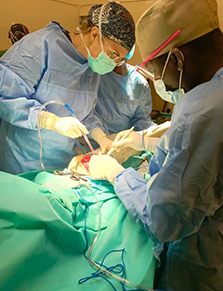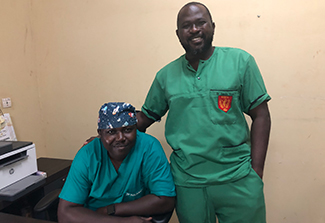Resolute vision: Caring for casualties in low-resource conflict settings
July/August 2025 | Volume 24 Number 4
 Photo courtesy of Hannah WildDr. Hannah Wild and Colonel Bassinga in the operating room
Photo courtesy of Hannah WildDr. Hannah Wild and Colonel Bassinga in the operating room
“When people think of military trauma care, they often think of what existed in Iraq and Afghanistan. But that paradigm has shifted,” says Dr. Hannah Binzen Wild, a former Fogarty fellow whose project in Burkina Faso focused on casualty care.
Unlike the wars in the Middle East, irregular warfare as well as large-scale combat operations between great powers will not be characterized by air superiority or intact echelons of care. Instead, U.S. military trauma care personnel may face conditions resembling those seen in Burkina Faso---prolonged transportation times, restricted supply chains, and severe resource limitations.
Solutions devised by trauma care teams in Burkina Faso reflect long years of warfare experience in a context that might more closely resemble what the U.S. may face in the future. “It would be ideal to synthesize these lessons, which can be beneficial to the U.S. for the planning and preparedness of its military, while also providing more resources and technical advisory support to personnel in low-resource conflict settings,” says Wild, now a general surgery resident at the University of Washington.
Providing care during conflicts
Wild spoke at July’s orientation for Fogarty’s
Launching Future Leaders in Global Health Research Training (LAUNCH) Program. During her fellowship year, she worked on a range of proposals in Burkina Faso, all focused on trying to improve casualty care for patients with conflict-related injuries.
“The formal project was piloting integration of explosive ordnance risk education with community first aid responder training in communities affected by the threat of IEDs (improvised explosive devices),” says Wild. Led by Dr. Nicolas Meda, a professor at University of Ouagadougou in Burkina Faso, Wild’s team conducted this pilot through a collaboration with the Mines Advisory Group, a global advocacy group. (Mine action generally comprises explosive ordnance detection and clearance, risk education, and victim assistance.)
Programs like the Burkina Faso pilot are now underway in Syria, Afghanistan, and Mozambique. In fact, the
Antipersonnel Mine Ban Convention recognized the value of merging community first responder training with explosive ordnance risk education and added an integrated program to its most recent action plan.
 Photo courtesy of Hannah WildTwo colleagues/mentors: Colonels Sanou & Nacanabo at Captain Halassane Coulibaly Military hospital
Photo courtesy of Hannah WildTwo colleagues/mentors: Colonels Sanou & Nacanabo at Captain Halassane Coulibaly Military hospital
Necessary adaptations
In Burkina Faso, Wild collaborated closely with local military surgeons Dr. Yves Sanou and Dr. Yves Aziz Nacanabo. They conducted one of the largest analyses to date of local casualties (roughly 1,400) in the Sahel, the semiarid region of western and north-central Africa, filling a long-standing evidence gap on casualty care within local health systems.
The team continues to study other casualty care problems, such as tourniquet application and blood availability.
“High and tight is the adage—meaning, in a tactical situation under fire you don't have time to figure out precisely what's bleeding, so you place a tourniquet at the highest level on the affected limb.” This works well when a patient reaches trained caregivers within the “golden hour," yet, in some conflicts, transporting patients to care takes much longer.
“In our population, the majority were evacuated between 12 and 24 hours, so you have an unquantified proportion of unnecessary limb loss and even death from complications of tourniquet use.”
Narrative case-reports have described similar outcomes in Ukraine, yet robust clinical data are still lacking, so Wild and her colleagues, who've already published their own case reports in Burkina Faso, are collecting data to inform and adapt tourniquet application protocols for low-resource conflict settings.
Finding solutions
Separately, Wild directs the Explosive Weapons Trauma Care Collective (EXTRACCT), an organization that aims to reduce preventable death among casualties in low-resource conflict settings. Despite the lack of data on casualty care within local health systems, “One of the things we do know is that there is an increasing proportion of blast injury—catastrophic, multi-system injuries presenting in overburdened health systems.”
EXTRACCT’s concept is that nearly all of the advances in trauma care in high-resource settings have not yet reached low-resource conflict settings. While some of these solutions may never be feasible, others hold the potential to be implemented if they are adapted to the context.
Given that, in low-resource conflict settings, there isn’t one trauma system, but a “mishmash” of local, national, military, non-military actors, and humanitarian NGOs, Wild wonders, “What does it take to synthesize the right people to deliver the interventions that are feasible? What adaptations are required?” She sees partnerships between health systems and mine action groups as an effective strategy.
Life mission
Wild discovered her passion in life at a young age and never wavered.
“I was five years old during the Rwandan genocide and, being an early reader, I learned about it and could not comprehend how people knew that this was happening in the world and moved on with their lives.” As she grew older, Wild read about conflicts taking place in Bosnia and in the Middle East. “I decided to spend my life trying to be useful in this type of setting.”
Though her passion places her in harm’s way, Wild does not dwell on this. “I calculate and moderate risk as much as I can. But the purpose of my existence is making a contribution in this environment, so when you're lucky enough to be doing exactly what you're built to do and want to do, personal fear is not quite relevant.” Instead of dwelling on herself, she prefers to highlight the work of colleagues in low-resource conflict settings who provide care for the wounded under extraordinarily challenging conditions with little recognition.
“I follow the path that I think will make me most effective in mitigating human suffering,” says Wild.
More information
Updated August 20, 2025
To view Adobe PDF files,
download current, free accessible plug-ins from Adobe's website.
Related Fogarty Programs